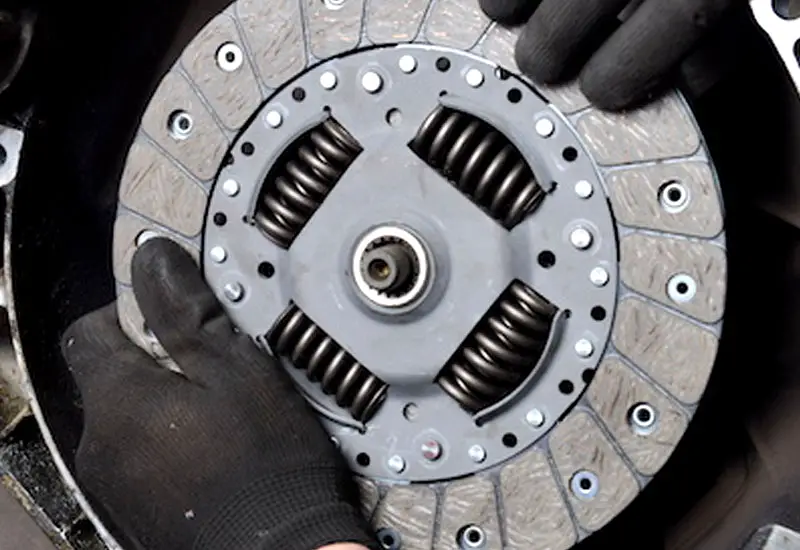As an Amazon Associate, I earn from qualifying purchases at no extra cost to you.
Does Auto Transmission Have Clutch? Unveiling the Truth
Have you ever wondered how automatic transmissions work in cars? While driving a car with an automatic transmission is incredibly convenient, it's easy to overlook the intricate mechanics happening behind the scenes. One question that often arises is: does an automatic transmission have a clutch? If you’re familiar with manual transmissions, you might immediately think of the clutch pedal and its crucial role in shifting gears. But automatic transmissions work differently. In this blog post, we'll break down how automatic transmissions work, whether they have a clutch, and what makes them distinct from manual systems. So, buckle up, and let’s explore this interesting topic in detail.

Understanding Transmission Types
Before diving into the specifics of clutches in automatic transmissions, it’s essential to understand the different types of transmissions commonly used in vehicles: manual and automatic.
Manual Transmission
A manual transmission relies on the driver's control to shift gears. It uses a clutch pedal, which disengages the engine from the transmission, allowing the driver to change gears smoothly. When you press the clutch pedal, the engine's power is temporarily cut off from the wheels, giving you the freedom to shift gears. Once the new gear is selected, you slowly release the clutch, re-engaging the engine and allowing power to be transferred to the wheels again.
Automatic Transmission
On the other hand, an automatic transmission is designed to shift gears without requiring manual input from the driver. It does this by using a system of sensors, hydraulic fluid, and mechanical components that adjust the gear ratio based on the car’s speed, engine RPM (revolutions per minute), and other factors. Because it doesn't require the driver to manually change gears, there’s no clutch pedal. Instead, an automatic transmission uses a torque converter, which performs a similar job but in a different way. Now that we’ve understood the basics of each type of transmission, let’s focus on whether automatic transmissions have a clutch.
Does an Automatic Transmission Have a Clutch?
To answer the question directly: No, traditional automatic transmissions don't have a conventional clutch pedal like manual transmissions. However, automatic transmissions still have components that function in a similar way to a clutch.
Torque Converter: The Automatic Transmission's Clutch Alternative
In automatic transmissions, the clutch is replaced by a torque converter. This device connects the engine to the transmission and transfers power from the engine to the wheels. While a clutch pedal in a manual transmission physically disengages the engine and transmission, the torque converter uses fluid dynamics to perform this job automatically.
The torque converter is made up of three primary components:
- Pump: The pump is connected to the engine and pushes fluid into the turbine.
- Turbine: The turbine receives fluid from the pump, and as it spins, it drives the vehicle's transmission.
- Stator: The stator redirects the fluid back toward the turbine to improve efficiency.
Together, these components allow for smooth transitions between gears without needing a traditional clutch. When you start your car, the engine's power is transferred through the torque converter, and the car moves even without pressing a clutch pedal. This is why you can drive an automatic car without worrying about manually engaging or disengaging gears.
Clutch Packs in Automatic Transmissions
Though automatic transmissions don't use a manual clutch pedal, they still rely on clutch packs to engage and disengage the gears internally. These clutch packs are groups of friction plates that work together to control which gears are engaged at any given time.
In a manual transmission, the driver operates the clutch to engage and disengage gears, but in an automatic transmission, hydraulic pressure automatically controls the clutch packs. When the transmission needs to shift gears, hydraulic fluid is pumped into the clutch packs, which then lock or release the gears to change the ratio. These hydraulic clutches are precisely timed to ensure smooth and efficient gear shifts.
The clutch packs inside an automatic transmission are essential for the smooth functioning of the transmission. These packs are used for specific gears, such as the first, second, third, or overdrive gear, and they help in the process of shifting without needing the intervention of the driver.
Key Differences Between Manual and Automatic Transmissions
Though both manual and automatic transmissions serve the same ultimate purpose – transferring power from the engine to the wheels – they do so in vastly different ways. Below, we'll explore some of the key differences.
1. Gear Shifting
- Manual Transmission: Gear shifting is a manual process. The driver has to use the clutch pedal to disengage the engine from the transmission, select the desired gear, and then release the clutch pedal to re-engage the engine.
- Automatic Transmission: Gear shifting is automatic. The transmission itself decides when to change gears based on factors like speed and engine performance. There is no clutch pedal involved, as the gear shifts are managed by the torque converter and hydraulic clutch packs.
2. Efficiency and Performance
- Manual Transmission: Manual transmissions generally offer better fuel efficiency and performance because the driver has more control over gear selection. For instance, you can manually downshift for extra power when accelerating or driving uphill.
- Automatic Transmission: While traditional automatic transmissions were less fuel-efficient in the past, modern automatics, especially with advanced features like CVTs (Continuously Variable Transmissions), offer comparable efficiency. Automatic transmissions have the advantage of convenience, allowing for smoother driving without the need to shift gears manually.
3. Driving Experience
- Manual Transmission: Driving a manual car requires more skill, coordination, and attention. The driver must be engaged with the vehicle to manage the clutch, gears, and throttle.
- Automatic Transmission: Automatic cars are easier to drive, especially in stop-and-go traffic, as they don't require the driver to engage a clutch or manually shift gears.
4. Maintenance and Repair
- Manual Transmission: Manual transmissions are typically simpler in design and easier to repair, but they do require more attention to the clutch, which will eventually wear out and need replacement.
- Automatic Transmission: Automatic transmissions are more complex and can be more expensive to repair due to their intricate components, such as the torque converter and hydraulic systems. However, because they don't have a clutch pedal, they may require less routine maintenance.
How Does the Torque Converter Compare to a Clutch?
One of the key elements in automatic transmissions is the torque converter, which takes the place of the clutch. While both components perform similar functions, the torque converter does so in a unique way.
Torque Converter’s Fluid Mechanics
Instead of physically disconnecting the engine from the transmission like a clutch does, the torque converter uses a liquid coupling. It allows the engine to spin independently of the transmission when the car is stopped, which is why automatic vehicles don't stall like manual cars do when idling.
The torque converter also acts as a fluid-based clutch. When the engine is at higher RPMs, the torque converter engages and transfers more power to the transmission. When the engine is at idle or low RPMs, the converter disengages slightly, reducing the load on the engine. This fluid-driven system offers smooth power transitions without the need for a driver to manage a clutch pedal.
Clutch Packs in an Automatic Transmission
As mentioned earlier, automatic transmissions still use clutch packs to engage gears. These clutch packs, controlled by hydraulic pressure, perform similar functions to the clutch in a manual transmission, but they are automated. When a gear shift is needed, the clutch pack engages the right gear to ensure smooth shifting without the need for a traditional clutch pedal.
Why Is There No Clutch Pedal in Automatic Transmissions?
The absence of a clutch pedal in automatic vehicles is one of the main differences between manual and automatic transmissions. The main reason behind this is convenience. Automatic transmissions are designed to make driving simpler by removing the need for the driver to manually change gears.
Instead of using a clutch pedal, automatic transmissions use sensors, hydraulic fluid, and sophisticated control systems to determine the optimal time to shift gears. The use of a torque converter also helps to manage the power transfer between the engine and the wheels smoothly.
This automatic operation allows the driver to focus more on steering, braking, and accelerating without worrying about gear shifts, making it ideal for city driving, long trips, and drivers who prefer a more relaxed driving experience.
I hope this article has helped clarify the role of clutches in automatic transmissions. While automatic transmissions don’t have a traditional clutch pedal like manual transmissions, they still utilize clutch-like components, such as the torque converter and clutch packs, to facilitate smooth gear changes. Understanding how automatic transmissions work can enhance your driving experience and help you appreciate the sophisticated engineering that powers today's vehicles.
Are These Questions in Your Mind?
Is it true that automatic transmissions are less fuel-efficient than manuals?
While automatic transmissions used to be less efficient, modern automatics are now on par or even better than manual transmissions in terms of fuel economy.
Can a car with automatic transmission stall?
A car with automatic transmission is less likely to stall because the torque converter allows the engine to continue running even when the car is at a complete stop.
Do I need to replace the clutch in an automatic car?
Although automatic transmissions don't have a traditional clutch, they do have clutch packs that can wear out over time and may need replacement, especially in older vehicles.
Can I convert my manual transmission car to an automatic?
Yes, it's possible to convert a manual transmission car to an automatic, but it's an expensive and complex process that typically requires a complete transmission swap.
Is it easier to drive an automatic or manual transmission?
Driving an automatic transmission is easier, especially in heavy traffic, because it doesn't require managing a clutch or shifting gears manually.


